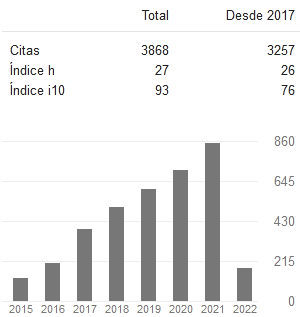THE LINKAGE OF THE LIVESTOCK CAREER IN THE CONTROL OF VULNERS OF VULNERABLE COMMUNITIES OF THE MANABITA SECTOR
Keywords:
Zoonoses; animals; software; link with the community.Abstract
The objective of this research was aimed at linking the students of the livestock career through their assessments to know the type of casual agents that trigger anthropozoonotic diseases as well as the state of health and sanitation in the chosen locations in order to be able train the personnel involved. The use of tools such as REDATAM allowed us to diagnose and evaluate the target population, starting from the selected variables with the purpose of directing the objectives of the subject to the link with the community. This software is part of the learning development of the ninth semester students of Pecuaria with the intention of knowing with better accuracy a more reliable statistic to the student to direct their training to the communities of the study.
Downloads
References
Agudelo-Flórez P., (2005). Leptospirosis: Diagnóstico serológico CES Medicina.ISSN impreso: 0120-8705 ISSN electrónico: 2215-9177
Aguirre, E. (1998). "Leptospirosis" en: Farreras Rozman, Medicina Interna 13ª ed., Mosby-Doyma SA, vol II págs 2385-2388, 1998.
Cabral, J., Villacaña, H., Fragoso, R. y Contreras, A. (1990). Perfil epidemiológico de la triquinosis en el Estado de Zacatecas Salud Pública de México. ISSN impreso: 0036-3634 ISSN electrónico: 1606-7916
Centro para el Control de Enfermedades (CDC). Plague [sitio en Internet]. [citado 7 Sept 2009]. Disponible en: http://www.cdc.gov/ncidod/dvbid/plague/index.htm
Fimia, R. (2012). Resistencia en vectores REDVET. Villa Clara, Cuba. Revista Electrónica de Veterinaria. ISSN electrónico: 1695-7504.
Guiteras J. (2011). La Peste Bubónica en La Habana .Revista Cubana de Salud Pública 2011. ISSN impreso: 0864-3466 ISSN electrónico: 1561-3127
James, N. (2004). El clima, los roedores y la enfermedad: ¿Es posible el pronóstico? Revista MVZ Córdoba 2004. ISSN impreso: 0122-0268 ISSN electrónico: 1909-0544
Levett, P.N. (2001). Leptospirosis. Clinical Microbiology Reviews 14: 296-326, 2001.
Menghi, C. (2010). Los parásitos en el túnel del tiempo Revista Argentina de Microbiología. ISSN impreso: 0325-7541 ISSN electrónico: 1851-7617
Moreno, H. (2014). Síndrome pulmonar por hantavirus, una amenaza latente en México. Revista de Especialidades Médico-Quirúrgicas 2014. ISSN impreso: 1665-7330
Pereira, S. (s/a). "Leptospirosis" en www.clinfec.org.uy. Cátedra de Enfermedades Infecciosas, Universidad de la República.
Sandow, K., Ramírez, W. (2005). Leptospirosis REDVET. Revista Electrónica de Veterinaria. ISSN electrónico: 1695-7504
Valdés, L., Carbonell, I., Delgado, J., Santín, M. (2008). Enfermedades Emergentes y Reemergentes. La Habana: Editorial Ciencias Médicas; 2008.
Valdés-Dapena, M. (2001). Enterobacterias. En: Llop A, Valdés-Dapena MM, Zuazo JL, editores. Microbiología y Parasitología Médicas. La Habana: Editorial Ciencias Médicas; 2001.p. 251-80.
Valdés-Dapena, M. (2009). Revista Electrónica de Veterinaria 2009 ISSN electrónico: 1695-7504
Weyant, R.S., Bragg, S.L., Kaufmann, A.F. (1999). Leptospira and Leptonema. En Murray P et al. Manual of Clinical Microbiology, pp 739-745. 7th. Edition, ASM, 1999.
Downloads
Published
How to Cite
Conference Proceedings Volume
Section
License
Copyright (c) 2020 Gabriel Antonio Navarrete Schettini, Alex Jacinto Roca Cedeño, Yesenia Aracely Zamora Cusme

This work is licensed under a Creative Commons Attribution 4.0 International License.
Usted es libre de:
- Compartir — copiar y redistribuir el material en cualquier medio o formato
- Adaptar — remezclar, transformar y construir a partir del material para cualquier propósito, incluso comercialmente.
Bajo los siguientes términos:
- Atribución — Usted debe dar crédito de manera adecuada, brindar un enlace a la licencia, e indicar si se han realizado cambios. Puede hacerlo en cualquier forma razonable, pero no de forma tal que sugiera que usted o su uso tienen el apoyo de la licenciante.
- No hay restricciones adicionales — No puede aplicar términos legales ni medidas tecnológicas que restrinjan legalmente a otras a hacer cualquier uso permitido por la licencia.













































